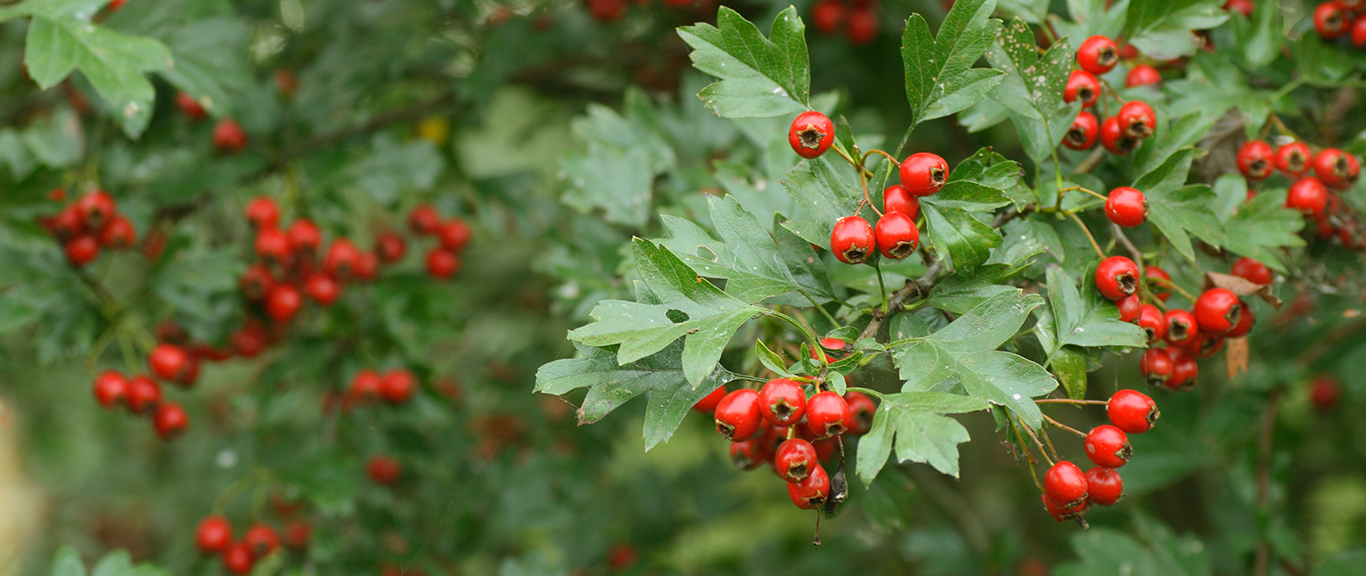Herb Spotlight - Hawthorn
Hawthorn (Crataegus monogyna)
Family: Rosaceae
Part Used: Leaf, Flower, Fruit
Flavor/Aroma: Sour, Sweet
Energetics: Warming, Drying
Chakra: Heart Zodiac: Taurus Planet: Mars Element: Fire
Deities: Flora, Greenman, Triple Goddess
Overview:
Hawthorn has a folklore as colorful as its berries- fairies are said to inhabit its branches, and to bring mischief to all those who gather the branches into their homes. Its flowers and berries are known to uplift both the physical and emotional heart, and support healthy cardiovascular function.

Botany:
Hawthorn grows as a thorny tree like shrub adorned with grayish, sturdy bark. It bears deep green, tri lobed leaves and white, rose like flowers that turn to bright red berries in the autumn months. They grow best in full sun, and are often found on the edges of wooded areas.
Cultivation and Harvesting:
Hawthorn trees express their fragrant flowers in the spring that develop into dense berries in the fall months, and are best harvested at peak ripeness. Hawthorn is native throughout much of the northern hemisphere, including Europe, northern Africa, Middle East, and parts of China.
Southern Oregon Cultivation:
Hawthorn trees are commonly found growing in the riparian zones of Oregon state, as well as pastures, woodlands, and overgrown fields. Its sweet fruit is a delicacy for local bird populations, and its flowers provide pollinators with nutritious sustenance. Hawthorn trees are easily grown as an ornamental and landscape plant, and will thrive in the Southern Oregon climate.
History and Folklore:
Hawthorn was used in religious ceremonies, most notably as the crown of Jesus Christ. It was also used in Pagan rituals, as well as having both physical and energetic uses as a boundary tree or medicine- it was often planted on property borders for privacy and as an emotional barrier with an affinity to the heart. Hawthorn trees are also referred to as the dividing line between the tame and untamed worlds due to its affinity to grow on the edges of wild places. Amulets of the hawthorn tree were worn to ward off evil spirits, and branches were hung over the doors of the home for protection.
The aroma of the Hawthorn flowers is said to increase sexual desires and uplift the spirits, and its sweet, rose-like fragrance is detectable long before it is seen.³
Hawthorn Berries for Protection
Hawthorn trees have long held a place of reverence in folklore, woven into tales of enchantment and the unseen. These resilient trees were once seen as thresholds to the realm of the fae, a mystical gateway between our world and theirs. Tradition warned against disturbing or felling a hawthorn, fearing it could invite misfortune or displease the faeries, ushering in ill luck.
Beyond its magical associations, hawthorn's delicate blossoms and vibrant berries also carried themes of love and fertility in some European customs. Its flowers adorned wedding ceremonies, and the berries found their way into charms and spells, said to draw romantic connections.
Often found standing sentinel near ancient burial grounds, hawthorn trees were also regarded as guardians of the spirit world. Their life cycle mirrored the profound rhythm of existence: the spring blossoms symbolizing new beginnings, and the rich, red berries signaling the harvest and the approach of winter, embodying the cycle of life, death, and rebirth.
The hawthorn's presence was particularly prominent in May Day and Beltane celebrations, marking the vibrant return of spring. Its flowers and berries were gathered to adorn maypoles and festive altars, celebrating nature's vitality and the renewal of the season.
Modern Applications:
Hawthorn is indicated to support cardiovascular diseases, strokes, heart attacks, hypertension, hemorrhoids, and to increase capillary integrity due to its ability to strengthen the vascular integrity by nourishing connective tissues. It is also used to remedy general pain, rapid or irregular heartbeat, shortness of breath, respiratory disorders, and high cholesterol.1
Hawthorn fruit is used to favor wines, liquors, jellies, and candies throughout the world, but is particularly popular in China.3
Uses and Preparations:
Dried Herb Tea Preparation:
1 Tablespoon per cup of water; dried or fresh berries can be used in a variety of culinary applications.
Using a reusable tea bag or tea ball, immerse the loose dried herbs into boiling water and allow to steep for 5-10 minutes, preferably covered, in order to release the maximum amount of herbal goodness. Some herbal tea can carry a strong flavor. We recommend organic honey as a sweetener which preserves the beneficial herbal compounds.
Tincture:
3-6 mL up to 4 times per day, and more as needed.
Some herbal tinctures can have a strong flavor on their own. Adding your tincture to a glass of 6-8oz of water is one easy way to help, should you wish to dilute the flavor.
Recommended Usage:
It is important to remember that some bodies may react differently than others when using herbal products. Our recommended usage amounts are designed to be an average dosage only. If you have specific concerns about the usage amount or interaction with other medication, please consult with your doctor or health care practitioner prior to using our products.
Sun God Medicinals products that contain Hawthorn:
Virtus Men’s Health Herbal Tincture
Precautions:
Hawthorn is safe for tonic use. If you are on any heart medications, please speak with a qualified practitioner before using this herb. We recommend consulting with your practitioner if you are pregnant, or plan to become pregnant, or if you are using any other medications.
References:
- Orhan, IE., (2018). Phytochemical and Pharmacological Activity Profile of Crataegus oxyacantha L. (Hawthorn)- A Cardiac Herb. www.ncbi.nlm.nih.gov/pubmed/27655074
- Crataegus monogyna. (n.d.). www.sacredearth.com/ethnobotany/plantprofiles/hawthorn.php
- Herbal Medicine: Expanded Commission E. (n.d.). Retrieved from http://cms.herbalgram.org/expandedE/Hawthornberry.html
For educational purposes only. This information has not been evaluated by the Food and Drug Administration. This information is not intended to diagnose, treat, cure, or prevent any disease.


